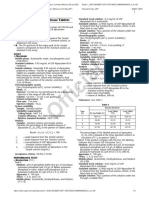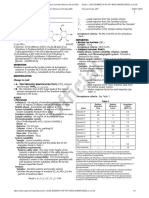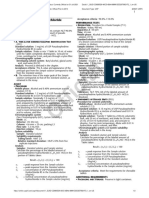Allantoin: 2092 Alfuzosin / Official Monographs USP 38
Allantoin: 2092 Alfuzosin / Official Monographs USP 38
Uploaded by
Gladdis Kamilah PratiwiCopyright:
Available Formats
Allantoin: 2092 Alfuzosin / Official Monographs USP 38
Allantoin: 2092 Alfuzosin / Official Monographs USP 38
Uploaded by
Gladdis Kamilah PratiwiOriginal Title
Copyright
Available Formats
Share this document
Did you find this document useful?
Is this content inappropriate?
Copyright:
Available Formats
Allantoin: 2092 Alfuzosin / Official Monographs USP 38
Allantoin: 2092 Alfuzosin / Official Monographs USP 38
Uploaded by
Gladdis Kamilah PratiwiCopyright:
Available Formats
Accessed from 10.6.1.
1 by merck1 on Mon May 11 21:21:16 EDT 2015
2092 Alfuzosin / Official Monographs USP 38
System suitability solution: 0.03 mg/mL of USP Al- N-Formyl analog: N-[3-[(4-Amino-6,7-dimethoxy-
fuzosin System Suitability Mixture A RS in Diluent from quinazolin-2-yl)(methyl)amino]propyl]formamide.
the System suitability stock solution C15H21N5O3 319.36
Standard stock solution: 0.15 mg/mL of USP Alfuzosin
Hydrochloride RS in methanol
Standard solution: 0.03 mg/mL of USP Alfuzosin Hy-
drochloride RS in Diluent from the Standard stock .
solution Allantoin
System suitability
Samples: System suitability solution and Standard
solution
Suitability requirements
Resolution: NLT 1.0 between alfuzosin and the
furamide analog, and NLT 1.0 between deacylated al-
fuzosin and the N-formyl analog, System suitability C4H6N4O3 158.12
solution Urea, (2,5-dioxo-4-imidazolidinyl)-;
Relative standard deviation: NMT 2.0%, Standard Allantoin [97-59-6].
solution
Analysis DEFINITION
Samples: Standard solution and Sample solution Allantoin contains NLT 98.5% and NMT 101.0% of
Calculate the percentage of each impurity in the por- C4H6N4O3.
tion of Tablets taken:
IDENTIFICATION
Result = (rU/rS) × (CS/CU) × 100 • A. INFRARED ABSORPTION 〈197K〉
• B. THIN-LAYER CHROMATOGRAPHIC IDENTIFICATION TEST
rU = peak response for each impurity from the 〈201〉: The RF value of the principal spot from Sample
Sample solution solution B corresponds to that from Standard solution A,
rS = peak response for alfuzosin from the Sample as described in the test for Organic Impurities.
solution
CS = concentration of USP Alfuzosin Hydrochloride ASSAY
RS in the Standard solution (mg/mL) • PROCEDURE
CU = nominal concentration of alfuzosin Sample: 120 mg
hydrochloride in the Sample solution Analysis: Transfer the Sample to a 100-mL beaker, dis-
(mg/mL) solve by stirring in 40 mL of water, and titrate with 0.1
Acceptance criteria: See Table 7. M sodium hydroxide. Use a suitable electrode system
(see Titrimetry 〈541〉). Each mL of 0.1 M sodium hy-
droxide is equivalent to 15.81 mg of C4H6N4O3.
Table 7 Acceptance criteria: 98.5%–101.0%
USP Monographs
Relative Acceptance
Retention Criteria, IMPURITIES
Name Time NMT (%) • RESIDUE ON IGNITION 〈281〉: NMT 0.1%
• ORGANIC IMPURITIES
Deacylated alfuzosina 0.46 0.40
.
Adsorbent: Cellulose
N-Formyl analogb . 0.50 0.30 Diluent: Methanol and water (1:1)
Alfuzosin 1.0 — Urea stock solution: 1 mg/mL of USP Urea RS in water
Furamide analogc . 1.18 —d .
Standard solution A: 1 mg/mL of USP Allantoin RS in
Any individual unspecified Diluent
— Standard solution B: 0.1 mg/mL of USP Urea RS in
impurity 0.20
Total impurities — 0.80 methanol, from Urea stock solution
Standard solution C: Standard solution A and Standard
a N2-(3-Aminopropyl)-6,7-dimethoxy-N2-methylquinazoline-2,4-diamine.
. . .
solution B (1:1)
b N-[3-[(4-Amino-6,7-dimethoxyquinazolin-2-yl)(methyl)ami-
.
no]propyl]formamide. Sample solution A: Transfer 0.10 g of Allantoin to a
c N-[3-[(4-Amino-6,7-dimethoxyquinazolin-2-yl)(methyl)ami- 10-mL volumetric flask, add 5 mL of water, dissolve by
heating, and allow to cool. Dilute with methanol to vol-
.
no]propyl]furan-2-carboxamide.
d Furamide analog, a component of USP Alfuzosin System Suitability Mix-
.
ume. [NOTE—Use immediately after preparation.]
ture A RS, is not a specified impurity. Sample solution B: Transfer 1 mL of Sample solution A
ADDITIONAL REQUIREMENTS to a 10-mL volumetric flask, and dilute with Diluent to
• PACKAGING AND STORAGE: Protect from light and mois- volume.
ture. Store at controlled room temperature. Spray reagent: 5 mg/mL of p-dimethylaminobenzalde-
• LABELING: When more than one Dissolution test is given, hyde in a mixture of methanol and hydrochloric acid
the labeling states the Dissolution test used only if Test 1 (3:1)
is not used. Application volume
• USP REFERENCE STANDARDS 〈11〉 Standard solution A: 5 µL
USP Alfuzosin Hydrochloride RS Standard solution B: 5 µL
USP Alfuzosin System Suitability Mixture A RS Standard solution C: 5 µL
Furamide analog: N-{3-[(4-Amino-6,7-dimethoxy- Sample solution A: 10 µL
quinazolin-2-yl)(methyl)amino]propyl}furan- Sample solution B: 5 µL
2-carboxamide. Developing solvent system: Butyl alcohol, glacial ace-
C19H23N5O4 385.42 tic acid, and water (60:15:25)
Deacylated alfuzosin: N2-(3-Aminopropyl)-6,7- Analysis: Proceed as directed for Chromatography 〈621〉,
Thin-Layer Chromatography. Develop the chromatogram
.
dimethoxy-N2-methylquinazoline-2,4-diamine.
until the solvent front has moved about 10 cm. Spray
.
C14H21N5O2 291.35
the plate with Spray reagent, dry in a current of hot air,
and after 30 min examine under visible light.
Official from May 1, 2015
Copyright (c) 2015 The United States Pharmacopeial Convention. All rights reserved.
Accessed from 10.6.1.1 by merck1 on Mon May 11 21:21:16 EDT 2015
USP 38 Official Monographs / Allopurinol 2093
Acceptance criteria: Any spot from Sample solution A, Related compounds—[NOTE—Store and inject the Stan-
except for the principal spot, is not more intense than dard solution and the Test solution at 8°, using a cooled
the spot from Standard solution B (NMT 0.5%). The test autosampler.]
is not valid unless the principal spots from Standard so- Solution A—Dissolve 1.25 g of monobasic potassium
lution C are clearly separated. phosphate in 1000 mL of water, filter, and degas.
SPECIFIC TESTS Solution B—Use methanol.
• ACIDITY OR ALKALINITY Mobile phase—Use variable mixtures of Solution A and So-
Sample solution: 5 mg/mL in carbon dioxide-free water lution B as directed for Chromatographic system. Make ad-
Analysis: To 5 mL of the Sample solution add 5 mL of justments if necessary (see System Suitability under Chroma-
water, 0.1 mL of methyl red TS, and 0.2 mL of 0.01 M tography 〈621〉).
sodium hydroxide. Diluent—Prepare a mixture of Solution A and Solution B
Acceptance criteria: A yellow color is observed. The (90:10).
solution turns red upon the addition of 0.4 mL of 0.01 Allopurinol related compound F solution—Accurately weigh
M hydrochloric acid. about 5 mg of USP Allopurinol Related Compound F RS into
• LOSS ON DRYING 〈731〉: Dry a sample at 105° to constant a suitable flask. Add 2.0 mL of 0.1 N sodium hydroxide,
weight: it loses NMT 0.1% of its weight. promptly sonicate with swirling for 1 to 3 minutes to dis-
• REDUCING SUBSTANCES solve, add 80 mL of Diluent, and sonicate for an additional
Sample solution: 1.0 g of Allantoin in 10 mL of water. 5 minutes.
Shake for 2 min, and filter.
Analysis: To the Sample solution add 1.5 mL of 0.02 M Standard stock solution—Accurately weigh about 5 mg
potassium permanganate. each of USP Allopurinol RS, USP Allopurinol Related Com-
Acceptance criteria: The solution remains violet for at pound A RS, USP Allopurinol Related Compound B RS, USP
least 10 min. Allopurinol Related Compound C RS, USP Allopurinol Re-
lated Compound D RS, and USP Allopurinol Related Com-
ADDITIONAL REQUIREMENTS pound E RS, and transfer to a 100-mL volumetric flask. Add
• USP REFERENCE STANDARDS 〈11〉 2.0 mL of 0.1 N sodium hydroxide, promptly sonicate with
USP Allantoin RS swirling for not more than 1 minute to dissolve, add the
USP Urea RS entire volume of Allopurinol related compound F solution to
the flask, rinse the flask in which Allopurinol related com-
pound F solution was prepared with a small amount of Dilu-
ent, and add the rinsings to the solution. Sonicate for an
additional 5 minutes. Dilute with Diluent to volume. [NOTE—
This solution is stable for 48 hours when stored at 8°.]
Allopurinol
.
Standard solution—Quantitatively dilute an accurately
measured volume of the Standard stock solution with Diluent
to obtain a solution having known concentrations of about
0.5 µg of allopurinol and about 0.5 µg each of allopurinol
USP Monographs
related compounds A, B C, D, E, and F per mL.
Test solution—Transfer about 25 mg of Allopurinol, accu-
C5H4N4O 136.11 rately weighed, to a 100-mL volumetric flask, add 5.0 mL of
4H-Pyrazolo[3,4-d]pyrimidin-4-one, 1,5-dihydro-. 0.1 N sodium hydroxide to dissolve, promptly sonicate with
1,5-Dihydro-4H-pyrazolo[3,4-d]pyrimidin-4-one. swirling for not more than 1 minute, add 80 mL of Diluent,
1H-Pyrazolo[3,4-d]pyrimidin-4-ol [315-30-0]. and sonicate for an additional 5 minutes. Dilute with Diluent
to volume.
» Allopurinol contains not less than 98.0 percent Chromatographic system (see Chromatography 〈621〉)—The
and not more than 102.0 percent of C5H4N4O, liquid chromatograph is equipped with a 220-nm detector
and a 4.6-mm × 25-cm column that contains 5-µm packing
calculated on the dried basis. L1. The column temperature is maintained at 30°. The flow
Packaging and storage—Preserve in well-closed contain- rate is about 1.0 mL per minute. The chromatograph is pro-
ers. Store at room temperature. grammed as follows.
USP Reference standards 〈11〉—
USP Allopurinol RS Time Solution A Solution B
USP Allopurinol Related Compound A RS (minutes) (%) (%) Elution
3-Amino-4-carboxamidopyrazole hemisulfate. 0–30 90→70 10→30 linear gradient
(C4H6N4O)2 · H2SO4 350.32 30–35 70 30 isocratic
USP Allopurinol Related Compound B RS 35–36 70→90 30→10 linear gradient
5-(Formylamino)-1H-pyrazole-4-carboxamide. 36–46 90 10 re-equilibration
C5H6N4O2 154.13
USP Allopurinol Related Compound C RS Chromatograph the Standard solution, identify the peaks
N-(4H-1,2,4-Triazol-4-yl)-1H-pyrazole-4-carboxamide. (see Table 1), and record the peak responses as directed for
C6H6N6O 178.15 Procedure: the resolution, R, between allopurinol related
USP Allopurinol Related Compound D RS compounds C and B is not less than 0.8; and the tailing
Ethyl 5-amino-1H-pyrazole-4-carboxylate. factor for the allopurinol peak is not more than 1.5.
C6H9N3O2 155.15 Procedure—Separately inject equal volumes (about 40 µL)
USP Allopurinol Related Compound E RS of the Standard solution and the Test solution into the chro-
Ethyl 5-(formylamino)-1H-pyrazole-4-carboxylate. matograph, record the chromatograms, and identify the al-
USP Allopurinol Related Compound F RS lopurinol peak and the peaks due to impurities listed in Ta-
Ethyl 3-(2-carbethoxy-2-cyanoethenyl)amino-1H- ble 1.
pyrazole-4-carboxylate.
Identification, Infrared Absorption 〈197K〉.
Loss on drying 〈731〉—Dry it in vacuum at 105° for
5 hours: it loses not more than 0.5% of its weight.
Official from May 1, 2015
Copyright (c) 2015 The United States Pharmacopeial Convention. All rights reserved.
You might also like
- Practice Problems (Chapter 5) Stoichiometry - KEYDocument3 pagesPractice Problems (Chapter 5) Stoichiometry - KEYGracia ProgellaNo ratings yet
- Filterable and Nonfilterable Matter in Water: Standard Test Method ForDocument7 pagesFilterable and Nonfilterable Matter in Water: Standard Test Method ForRashaZakaria100% (2)
- Paracetamol Tablet USP41Document3 pagesParacetamol Tablet USP41jayvee francisco100% (2)
- Shand - Jurs Conservation Vent 94020-3CDocument8 pagesShand - Jurs Conservation Vent 94020-3CRuban PaulNo ratings yet
- Alprazolam Extended-Release TabletsDocument5 pagesAlprazolam Extended-Release TabletsRaquel BcNo ratings yet
- Azithromycin Tabs Pending NitrDocument4 pagesAzithromycin Tabs Pending NitrKyle Isidro MaleNo ratings yet
- USP41 DesloratadineDocument2 pagesUSP41 DesloratadineAlejandro RestrepoNo ratings yet
- Zolpidem Tartrate Extended-Release TabletsDocument4 pagesZolpidem Tartrate Extended-Release Tabletsehsan050628No ratings yet
- Amoxicillin Capsules RB NoticeDocument4 pagesAmoxicillin Capsules RB NoticeJersa Mae MaravillaNo ratings yet
- Telmisartan TabletsDocument2 pagesTelmisartan Tabletsdini hanifaNo ratings yet
- Acarbose PDFDocument2 pagesAcarbose PDFGladdis Kamilah PratiwiNo ratings yet
- AcarboseDocument2 pagesAcarboseRaquel BcNo ratings yet
- AdenosineDocument2 pagesAdenosineVu AnNo ratings yet
- Fluconazole Tablets USPDocument3 pagesFluconazole Tablets USPSatyawanNo ratings yet
- USP Monographs - Azithromycin TabletDocument12 pagesUSP Monographs - Azithromycin TabletPowellAbogado100% (1)
- AmlodipineDocument2 pagesAmlodipineRph AinNo ratings yet
- Diphenhydramine HCLDocument4 pagesDiphenhydramine HCLOkta Dewi PermatasariNo ratings yet
- AcarboseDocument2 pagesAcarboseHỗn ĐộnNo ratings yet
- Atomoxetine CapsulesDocument2 pagesAtomoxetine Capsulesehsan050628No ratings yet
- Abacavir Oral Solution PDFDocument2 pagesAbacavir Oral Solution PDFGladdis Kamilah PratiwiNo ratings yet
- Sodium Fluoride TabletsDocument1 pageSodium Fluoride Tabletsghofrane ekvlNo ratings yet
- Valsartan TabletsDocument2 pagesValsartan TabletsThảo PhanNo ratings yet
- USP-NF Cabergoline TabletsDocument4 pagesUSP-NF Cabergoline Tabletsanon_993394650No ratings yet
- Etoposide Injection: 3838 Etoposide / Official Monographs USP 39Document2 pagesEtoposide Injection: 3838 Etoposide / Official Monographs USP 39rifki muhama ramdaniNo ratings yet
- Acetaminophen Oral Suspension PDFDocument2 pagesAcetaminophen Oral Suspension PDFGladdis Kamilah PratiwiNo ratings yet
- GUID - 2 en-USDocument2 pagesGUID - 2 en-USLucélia ScachetiNo ratings yet
- AdapaleneDocument3 pagesAdapaleneRaquel BcNo ratings yet
- Acetaminophen and Codeine Phosphate TabletsDocument2 pagesAcetaminophen and Codeine Phosphate TabletsChi KimNo ratings yet
- Acepromazine Maleate TabletsDocument1 pageAcepromazine Maleate TabletsRaquel BcNo ratings yet
- Acetaminophen For Effervescent Oral SolutionDocument1 pageAcetaminophen For Effervescent Oral SolutionMaximiliano OjedaNo ratings yet
- Alpha Lipoic AcidDocument2 pagesAlpha Lipoic AcidRaquel Bc100% (1)
- Acarbose USPDocument2 pagesAcarbose USPДарія ОсадчаNo ratings yet
- USP 2024... Acetaminophen For Effervescent Oral SolutionDocument1 pageUSP 2024... Acetaminophen For Effervescent Oral SolutionNeeraj SinghNo ratings yet
- Azithromycin Tablets USPDocument3 pagesAzithromycin Tablets USPstevenjosea5802No ratings yet
- USP2024... Acepromazine Maleate TabletsDocument1 pageUSP2024... Acepromazine Maleate TabletsNeeraj SinghNo ratings yet
- Valsartan TabletsDocument2 pagesValsartan TabletsKasidit SornchaiNo ratings yet
- USP 2024 Monograph Acarbose TabletsDocument2 pagesUSP 2024 Monograph Acarbose TabletsNeeraj SinghNo ratings yet
- Usp39 2089Document2 pagesUsp39 2089Yared Padron LopezNo ratings yet
- Acetaminophen and Codeine Phosphate Oral SuspensionDocument2 pagesAcetaminophen and Codeine Phosphate Oral SuspensionChi KimNo ratings yet
- Valsartan RB NoticeDocument3 pagesValsartan RB NoticeJersa Mae MaravillaNo ratings yet
- Atropine SulfateDocument2 pagesAtropine SulfateTống Ái Linh NguyễnNo ratings yet
- USP-NF Tramadol Hydrochloride TabletsDocument4 pagesUSP-NF Tramadol Hydrochloride Tablets6410710053No ratings yet
- Sulconazole NitrateDocument2 pagesSulconazole NitrateJames ChenNo ratings yet
- Sertraline Hydrochloride TabletsDocument3 pagesSertraline Hydrochloride TabletsTấn Thành NguyễnNo ratings yet
- Acetaminophen and Codeine Phosphate Capsules - USPDocument2 pagesAcetaminophen and Codeine Phosphate Capsules - USPДарія ОсадчаNo ratings yet
- Acebutolol Hydrochloride Capsules - USPDocument2 pagesAcebutolol Hydrochloride Capsules - USPДарія ОсадчаNo ratings yet
- Zonisamide CapsulesDocument3 pagesZonisamide Capsulesghofrane ekvlNo ratings yet
- Adapalene GelDocument2 pagesAdapalene GelRaquel BcNo ratings yet
- Acepromazine Maleate TabletsDocument1 pageAcepromazine Maleate Tabletsjafranco.tfsNo ratings yet
- FluorouracilDocument2 pagesFluorouracilTrần Ngọc Bảo UyênNo ratings yet
- 3732-3733 Lysine AcetateDocument2 pages3732-3733 Lysine AcetateQuỳnh VõNo ratings yet
- Usp 41 - AtorvastatinDocument5 pagesUsp 41 - AtorvastatinlinaNo ratings yet
- Azelastine Hydrochloride Ophthalmic SolutionDocument2 pagesAzelastine Hydrochloride Ophthalmic SolutionHamza MaverickNo ratings yet
- Human Insulin Isophane Suspension and Human Insulin InjectionDocument2 pagesHuman Insulin Isophane Suspension and Human Insulin Injectionghofrane ekvlNo ratings yet
- (Acetic Acid) Glacial Acetic AcidDocument2 pages(Acetic Acid) Glacial Acetic AcidFiona ValenciaNo ratings yet
- Bendroflumethiazide TabletsDocument1 pageBendroflumethiazide TabletsBD EXPORTSNo ratings yet
- Pseudoephedrine Hydrochloride TabletsDocument2 pagesPseudoephedrine Hydrochloride TabletsK.m. Ehsan Morshed RanaNo ratings yet
- Naproxen Sodium TabletsDocument2 pagesNaproxen Sodium TabletsJersa Mae MaravillaNo ratings yet
- Acetaminophen and Aspirin Tablets - USPDocument2 pagesAcetaminophen and Aspirin Tablets - USPДарія ОсадчаNo ratings yet
- Xylometazoline Hydrochloride Nasal - 2020Document2 pagesXylometazoline Hydrochloride Nasal - 2020pharm.vigilanNo ratings yet
- GUID - 4 en-USDocument2 pagesGUID - 4 en-USFauzi AkbarrNo ratings yet
- Ramipril CapsulesDocument3 pagesRamipril CapsulesEcHie ChoiNo ratings yet
- Advanced Pharmaceutical analysisFrom EverandAdvanced Pharmaceutical analysisRating: 4.5 out of 5 stars4.5/5 (2)
- Acetaminophen Oral Solution PDFDocument1 pageAcetaminophen Oral Solution PDFGladdis Kamilah PratiwiNo ratings yet
- Acarbose PDFDocument2 pagesAcarbose PDFGladdis Kamilah PratiwiNo ratings yet
- Acetaminophen Oral Suspension PDFDocument2 pagesAcetaminophen Oral Suspension PDFGladdis Kamilah PratiwiNo ratings yet
- Allopurinol PDFDocument3 pagesAllopurinol PDFGladdis Kamilah PratiwiNo ratings yet
- Allopurinol Tablets PDFDocument2 pagesAllopurinol Tablets PDFGladdis Kamilah PratiwiNo ratings yet
- Abacavir Oral Solution PDFDocument2 pagesAbacavir Oral Solution PDFGladdis Kamilah PratiwiNo ratings yet
- Electrolysis HLDocument34 pagesElectrolysis HLRyan BoukaaNo ratings yet
- Effect of The Use of Ceramic Filters in Steel CastingDocument6 pagesEffect of The Use of Ceramic Filters in Steel CastingBrijesh YadavNo ratings yet
- Unit 3 The Cellular Basis of LifeDocument41 pagesUnit 3 The Cellular Basis of LifeEbenezer Abraham100% (1)
- PPG Hi-Temp™ 222 G: Product Data SheetDocument6 pagesPPG Hi-Temp™ 222 G: Product Data SheetJefry SandyNo ratings yet
- DonaldsonDocument24 pagesDonaldsonrajuhaveriNo ratings yet
- Granulation Part I PDFDocument42 pagesGranulation Part I PDFSohib ZreegatNo ratings yet
- Conductividad NIST 1423 VigenteDocument34 pagesConductividad NIST 1423 Vigentetvhogar garciaNo ratings yet
- Chapter 2 - Single Stage LLEDocument34 pagesChapter 2 - Single Stage LLEMUHAMMAD LUQMAN HAKIMI MOHD ZAMRINo ratings yet
- GRINNELL Figure 780 Grooved Snap Couplings 1-1/4 Thru 8 Inch (DN32 Thru DN200) General DescriptionDocument2 pagesGRINNELL Figure 780 Grooved Snap Couplings 1-1/4 Thru 8 Inch (DN32 Thru DN200) General DescriptionСергей КолесниковNo ratings yet
- Alkyl Halides: S5 Chemistry 29/NOV/2021Document31 pagesAlkyl Halides: S5 Chemistry 29/NOV/2021Nelima Stella mercyNo ratings yet
- Steel Handbook: Materials Reference BookDocument35 pagesSteel Handbook: Materials Reference BookChinmoy BaruahNo ratings yet
- Histopathologic Technic and (PDFDrive)Document513 pagesHistopathologic Technic and (PDFDrive)KIM KYRISH DELA CRUZNo ratings yet
- EIM 9 Quarter1.proposed BOW - MELCsDocument4 pagesEIM 9 Quarter1.proposed BOW - MELCsLand NozNo ratings yet
- Yeast The Soul of Beer's Aroma A ReviewDocument13 pagesYeast The Soul of Beer's Aroma A Review_juliogsNo ratings yet
- Pharmaceutics IDocument75 pagesPharmaceutics Ishahida hassanNo ratings yet
- Pharma ListDocument12 pagesPharma Listsales1No ratings yet
- Biomass Principles of Bio Conversion: SLIDE 1/29 Snsce/Eee/Res/Unit-4/P.SangeethaDocument15 pagesBiomass Principles of Bio Conversion: SLIDE 1/29 Snsce/Eee/Res/Unit-4/P.SangeethaNandakumarNo ratings yet
- Questions & Answers - JEE (Adv) - 2020 - Paper-1 - 1Document20 pagesQuestions & Answers - JEE (Adv) - 2020 - Paper-1 - 1lazy apeNo ratings yet
- Radiation and ScienceDocument2 pagesRadiation and ScienceBobNo ratings yet
- Method Formate-ISODocument4 pagesMethod Formate-ISOswapon kumar shillNo ratings yet
- Analytical Chem Notes For BST-1Document26 pagesAnalytical Chem Notes For BST-1Odongo TonnyNo ratings yet
- Material Receipt Record Pearl HeightsDocument132 pagesMaterial Receipt Record Pearl HeightsHitesh PrajapatiNo ratings yet
- Global Lateritic Nickel Resources: Mick Elias CSA Australia Pty LTDDocument33 pagesGlobal Lateritic Nickel Resources: Mick Elias CSA Australia Pty LTDagus irwansyahNo ratings yet
- Lab Manual 1Document3 pagesLab Manual 1hudaNo ratings yet
- Acknowledgement: Gawade S.R. Class Coordinator Prof. Shirke Sir, Principal Dr. Narve N.G. and All The StaffDocument16 pagesAcknowledgement: Gawade S.R. Class Coordinator Prof. Shirke Sir, Principal Dr. Narve N.G. and All The StaffShubham PhadtareNo ratings yet
- Chromatography LabDocument3 pagesChromatography Labashleygaboy86100% (1)
- Chapter 5 - StereochemistryDocument29 pagesChapter 5 - StereochemistryDenisdNo ratings yet




























































































